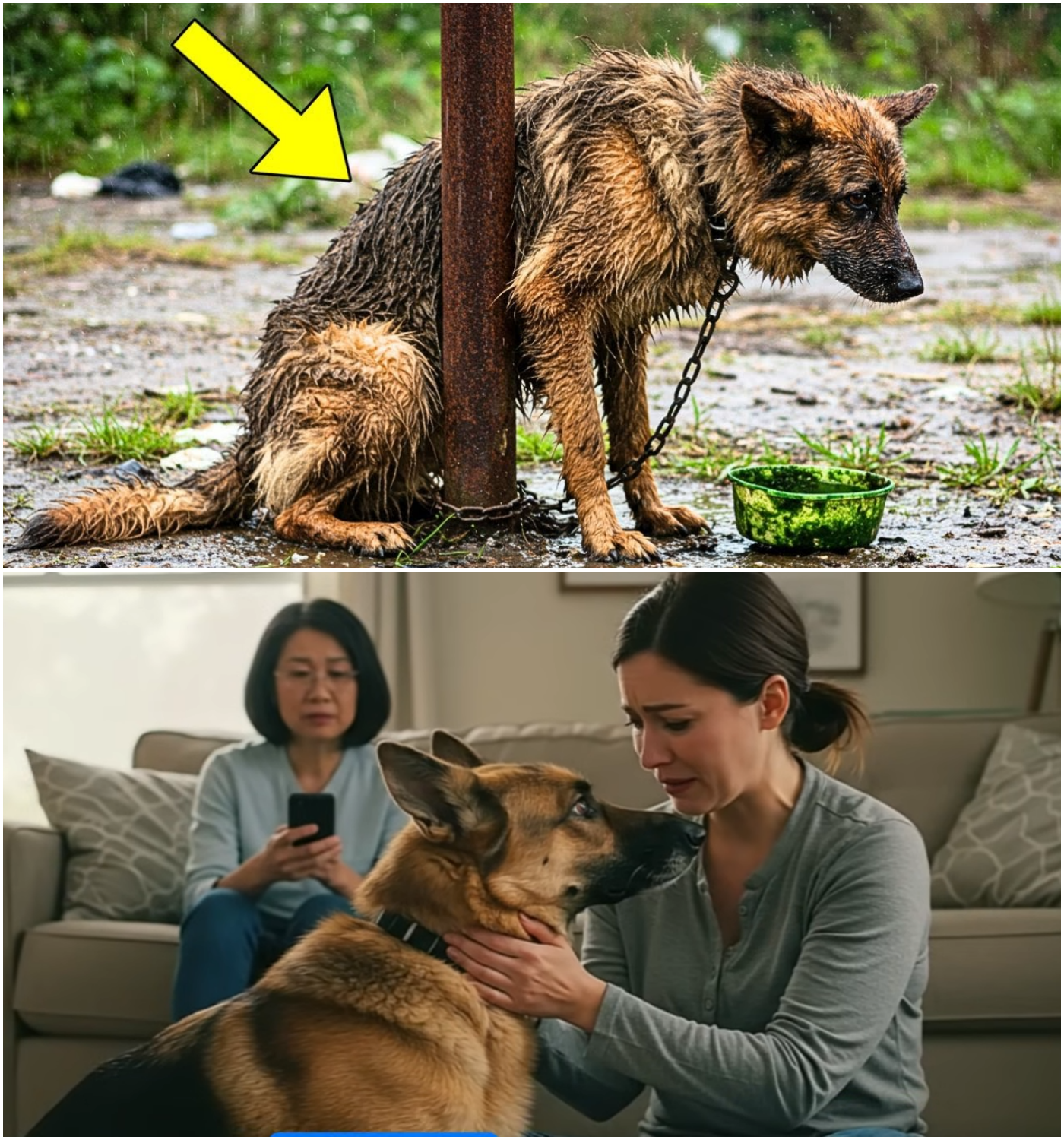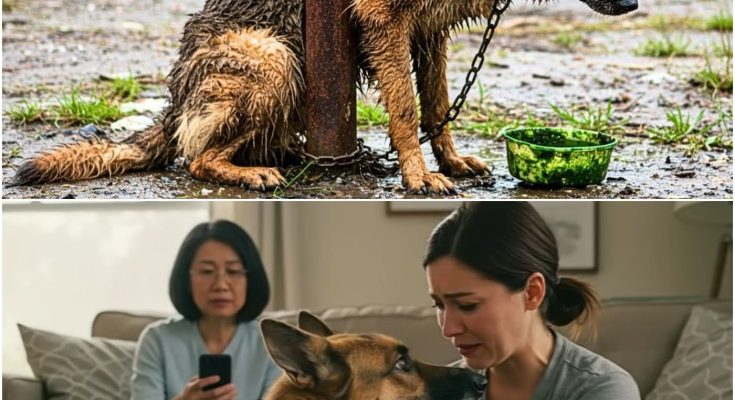Melissa, a veterinary technician, was rushing to catch her bus to work when she cut through an abandoned lot. There, half-hidden by weeds and soaked to the bone, was a matted, filthy dog chained to a rusted pole. At first glance, Melissa thought it was a pile of garbage. But as she drew closer, she saw the truth: a female German Shepherd, so emaciated and dirty that she was barely recognizable as a dog.
The dog’s fur was caked with dirt and waste, her neck raw and bleeding from a collar that had become embedded in her skin. Her eyes, clouded with infection but still painfully alert, met Melissa’s gaze with a mixture of fear and hopelessness.
“I’m going to help you,” Melissa whispered, kneeling at a safe distance. She called her clinic, explaining she’d be late — she’d found a case of deliberate neglect, the worst she’d ever seen.
Within half an hour, her supervisor and two vet techs arrived with a crate, muzzle, and bolt cutters. The rescue was surprisingly calm. The German Shepherd, too weak to resist, allowed them to cut her free. As Melissa looked into her eyes, she felt an inexplicable connection. “We’ll call her Hope,” suggested the clinic owner, but Melissa shook her head. “No, her name is Duchess. She’s not what they made her — she’s who she was meant to be.”
The Road to Recovery

At the clinic, Duchess’s condition stunned even veteran professionals. She was severely malnourished, dehydrated, riddled with infections, and suffering from anemia and likely heartworm. Her body was a map of suffering: open sores, broken teeth, and paw pads worn raw. “I’m amazed she’s still alive,” one vet remarked.
Melissa stayed late to help shave away Duchess’s matted fur and treat her wounds. Beneath the filth, a beautiful, purebred German Shepherd began to emerge. Despite months of neglect, Duchess showed no aggression — only a wary hopefulness, as if she still wanted to believe in kindness.
Melissa, who lived in a small apartment that didn’t allow pets and worked long hours, surprised even herself by volunteering to foster Duchess through recovery. “I can’t explain it, but I need to do this,” she insisted.
A miracle came the next day when Laura Chen, a clinic client whose elderly dog had recently passed away, offered her home as a foster space. Duchess would stay at the clinic for stabilization, then move to Laura’s quiet house with a fenced yard. Melissa visited daily to provide care.
Learning to Trust Again
Duchess’s spirit shone through even as she struggled to heal. She flinched at sudden movements but leaned—almost imperceptibly—toward gentle contact. The first tail wag, the first peaceful sleep, the first treat accepted from an open palm—each tiny milestone was celebrated.
When Duchess moved to Laura’s home, her psychological recovery truly began. She spent days huddled in a corner, too afraid to explore. Melissa visited, reading aloud in a calm voice, letting Duchess set the pace. Three weeks in, Duchess made her first deliberate contact, sniffing Melissa’s hand for a brief, precious moment. Melissa cried tears of relief in her car afterward, overwhelmed by the dog’s courage to trust again.
A Viral Transformation
Melissa documented Duchess’s recovery for the clinic’s records. When a short video of Duchess placing her head in Melissa’s lap was shared online, it unexpectedly went viral. Within a day, over 100,000 people had watched the once-broken dog choose to trust a human again. The story spread to local news, then to a national morning show.
Donations poured in, allowing Melissa and Laura to create a nonprofit, Duchess’s Second Chance, supporting rehabilitation for other severely neglected animals. Duchess’s progress was steady: she gained weight, completed heartworm treatment, and began basic training. Most remarkable was her deepening bond with Melissa, who became her emotional anchor.
The Princess Becomes a Healer
Duchess’s empathy and intuition were extraordinary. She seemed to sense Melissa’s moods, offering comfort with a nudge or a gentle head in her lap. On a behavioral expert’s advice, Melissa had Duchess evaluated for therapy dog training. To everyone’s amazement, Duchess excelled—her trauma had given her a unique sensitivity to human emotions.
Six months after her rescue, Duchess attended her first public event, a fundraiser for the foundation. Wearing her therapy dog vest, she moved calmly through the crowd, her regal bearing earning her the nickname “Princess” among attendees.
Soon after, a children’s hospital reached out. Could Duchess visit their long-term patients? Her first visit astonished everyone: she played gently with an energetic child, then sat quietly with a withdrawn teenager, finally drawing a response from a boy who hadn’t spoken since his accident. Duchess’s ability to connect transcended language, bringing comfort where words failed.
A Miraculous Twist
The most dramatic moment came after a bus accident sent dozens of traumatized children to the hospital. Duchess was asked to help with crisis response. For three hours, she moved among the children, offering calm presence and comfort. One severely autistic boy, unreachable by staff, finally reached out to touch her ear. “She’s doing what we can’t,” whispered a social worker.
Inspired by Duchess, the hospital developed new protocols for animal-assisted crisis intervention. Her foundation grew, supporting animal rescue and therapy programs across the state. Duchess’s Law, recently passed, strengthened penalties for animal cruelty and neglect.
A Lasting Legacy
One year after her rescue, a bronze statue of Duchess was unveiled in the town square, honoring her journey from abandoned prisoner to community healer. Melissa, who left her job to work full-time for the foundation, watched Duchess approach a young woman in a wheelchair, offering her trademark gentle connection.
“She creates a bridge across trauma,” said Dr. Landry, the foundation’s clinical director. “Her presence says, ‘I know what darkness feels like, and I’m here with you in it.’”
Duchess’s story is a testament to the power of compassion, resilience, and second chances. From forgotten and chained to celebrated and cherished, she reminds us all that the darkest beginnings can lead to the brightest transformations.






